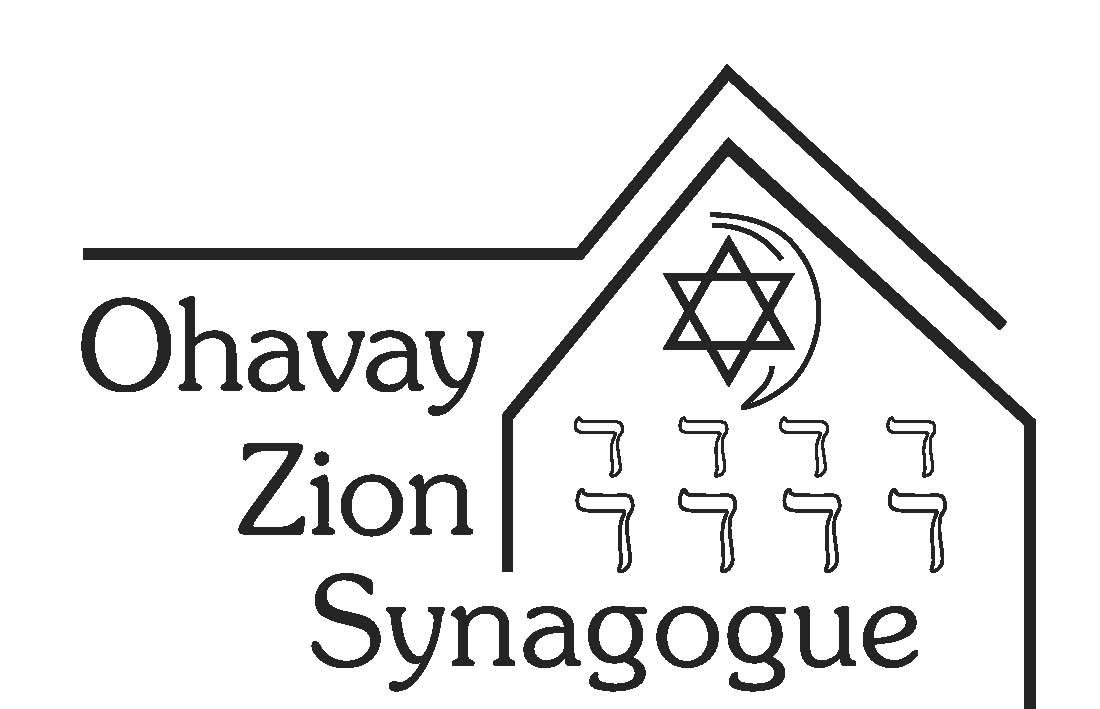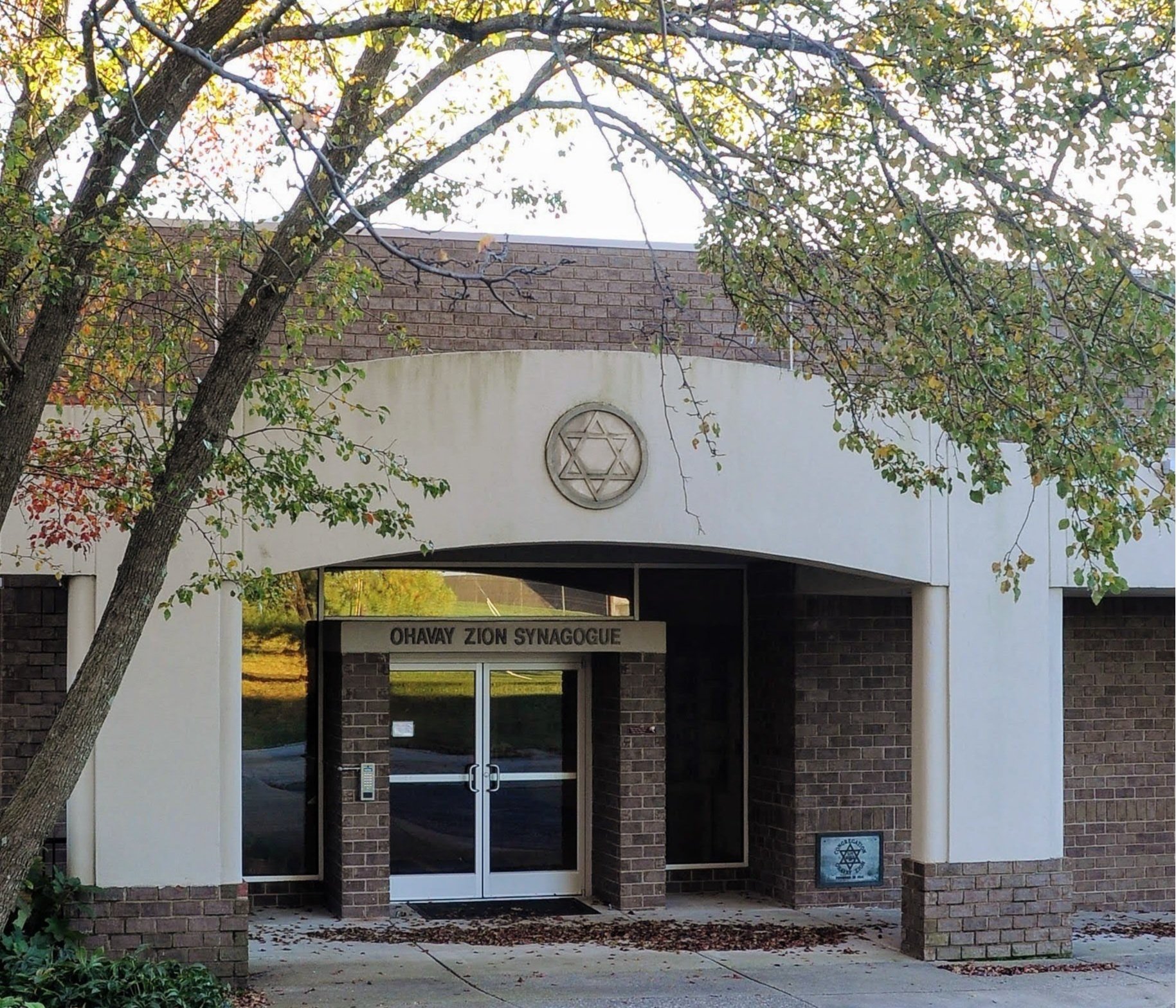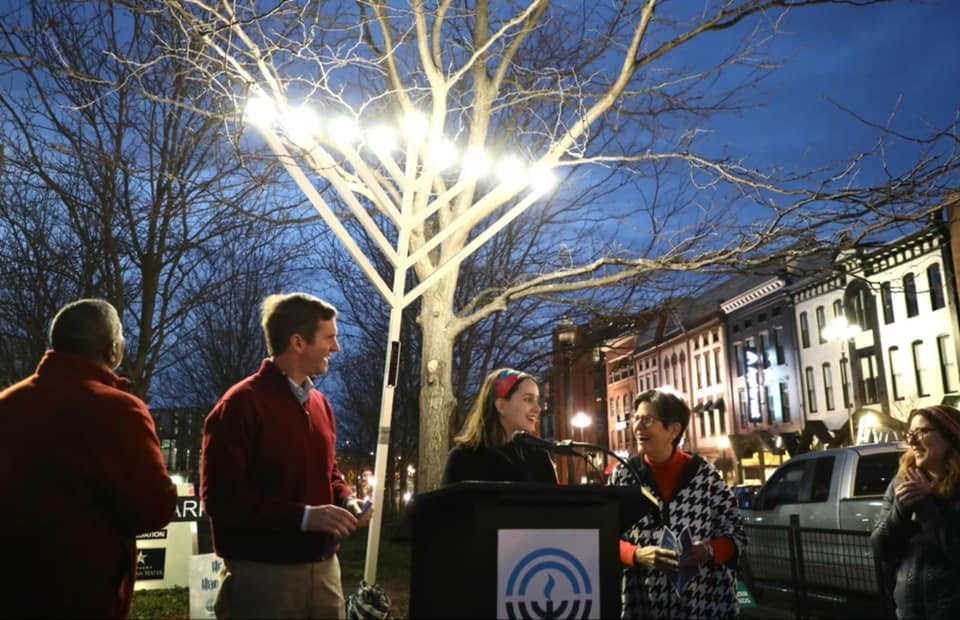IN THE BEGINNING
Just after the turn of the 20th century, the first of our founders emigrated to Lexington, Kentucky from the shtetl of Pushelot , Lithuania. Having found relative safety and stability, these founders encouraged their relatives and friends to join them here, and the community was born. The Orthodox Jewish community then consisted of just 8 or 10 families. They gathered in downtown stores for daily Minyans. (A practice which still lingered 50 years later with Minyans in Abie Grossman’s store on Water Street, until it closed in the late 60’s.) Traditionally, the Odd Fellows hall on West Short Street was rented for the High Holy Days.
The Early Synagogue Building Days
It was Joe Rosenberg who learned of the availability of a church building on West Maxwell Street. The Presbyterian Church was moving to East Maxwell. Ohavay Zion purchased their old building, and at last, in 1914, the congregation had a home.
The newly purchased church building consisted of little more than a sanctuary, and many changes were required before it could be used as a Synagogue. The old organ was removed from the southwest corner of the sanctuary and with the help of many of the congregants, the building was renovated.
For a number of years after the Synagogue was bought, there was no full time Rabbi. Although there are no written records, it is generally agreed Rabbi Jacob Lowenthal arrived in 1919 to serve as Ohavay Zion’s first full time, salaried Rabbi. During the six years he remained in Lexington, Rabbi Lowenthal was Shochet and Mohel as well as Rabbi.
Early Rabbis
Rabbis came and went. One who stands out was Rabbi Jacob Danziger, who arrived as a bachelor in 1929, and married Ann Rosenberg before moving on to Huntington, West Virginia three years later. Other early Rabbis were: Rabbi Sofar, Rabbi Aaron, Rabbi Shapo, Rabbi Garfinkle, Rabbi Goldman, Rabbi Klibinsky, Rabbi Lowenthal, and Rabbi Prero, each of whom served about three years. Part of the difficulty of holding a Rabbi was the lack of housing within walking distance of the Synagogue. To solve this problem a house was purchased on Kilmore Court. Rabbi Sivawitz, an exceptional Cantor, and then Rabbi Beckerman lived in this house until it was sold and another, on Preston Court, was purchased. Rabbi William Frankel and Rabbi Albert Pappenheim each lived in the Preston Court house.
For many years, the Synagogue was without a Rabbi. Fortunately, congregants were able to conduct services and perform other duties. In the pioneer days, Sol Kahn, Nathan Cantor and Berel Kravetz were Chazzans. Rev. Samuel Krasne served as Chazzan and Shochet, as well as Mohel. Of widespread fame in the Lexington Jewish community was Rev. Harry Goller who davened on holidays and gave sermons in Yiddish when there was no Rabbi available. In addition, Mr. Goller’s Kosher Butcher Shop on 4th and Upper Streets provided the Orthodox Jews with meat, poultry and delicatessen for over 40 years. During the war years, before Rabbi Beckerman came, Mr. Goller and Dr. Abe Wikler conducted the services.
It was about this time that Morris Scherago started a Sunday School and Berel Kravetz became the second man to serve the congregation as president. Both Sunday School and daily Hebrew School classes were held in the basement of the synagogue. As new classes were added, they were placed in various sections of the sanctuary.
Since the building consisted of just the sanctuary and the basement, Purim bazaars and Hanukkah parties were held in rented halls over the Water Street produce market, and in rooms over Woolworth’s and Skuller’s on Main Street. A few years later, a small house on South Upper Street was bought. With the removal of several walls, it became a Social Hall for the congregation. Religious School, and all special functions were held there. Finally, there was a place, small as it was, in addition to the sanctuary, where people could socialize.
Complete List of Founders
David Ades, Max Ades, Jacob Alpern, Morris Alpern, Max Backer, Morris Baker, Phillip Gall, S. Glick, Sam Goldberg, Harry Goller, Joe Green, Harry Greenfield, Dan Grossman, Hyman Grossman, Nathan Grossman, Ben Herman, Nathan Herman, Sam Herman, L.J. Horne, John Jacobs, E. Kraus, B. Kravitz, Beryl Kravitz, Louis Kravitz, N. Kravitz, Robert Kravitz, B. Levin, Benjamin Levy, Isadore Levy, Joe Levy, Abe Marks, Max Munich, J. Pearlman, Joe Rosenberg, Dave Shraberg, H.Z. Schwartzman, Harry Simon, A. Stein, Ben Wides, Jacob Wides, Morris Wides
Expansion of the 40’s & 50’s
By 1940, when A. R. Prero was Rabbi, major changes in the size of the Synagogue structure were becoming critical to our survival. It was obvious that the house on South Upper Street was inadequate for our needs. As was true in our earliest days, functions were being held in various locations around the city. Rabbi Prero promoted a rather ambitious plan for adding an auditorium to the main synagogue building on Maxwell Street. I.A. Paritz, the building chairman and Ben Herman, president of the congregation, headed the project. David Lieverman, an architect, volunteered the plans. Had it not been for 11 members of this congregation who signed personal notes, work would not have been undertaken before World War II and the new addition may not have become a reality, certainly not until the end of the war. Those congregants were: Harry Gordon, Ben Herman, Nathan Herman, Ben Levy, Joe Levy, Max Munich, Erwin Neuman, I.A. Partiz, Joe Rosenberg. David Shraberg and Morris Wides. With the help of the Ladies Auxiliary, who assumed the responsibility of furnishing the kitchen and the Young People’ s Group, who furnished the lounge in the basement, the building was completed and ready for dedication in November of 1941.
A beautifully landscaped walkway along the west side of the sanctuary led to double doors that served as the main entrance to the new addition. During the same time that the auditorium was being built, the sanctuary was given a facelift. It was then that the porches were removed from the two entrances and rounded concrete steps were put in their place. At last, we had converted the originally isolated sanctuary into an integrated complex that would meet the social, as well as the religious needs of the congregation for the foreseeable future.
Congregational presidents during this period included Erwin Neuman, Nathan Herman, Ed Greenfield, Eddie Kessler, Seymour Moskoswitz and Sam Block. Mr. Greenfield had retired, and he and his wife Betty devoted themselves almost full time to the Synagogue. It was during his presidency, in 1948, that the Sanctuary was again redecorated. At the same time, David Ades had the pulpit rebuilt in memory of his parents and sister, and benches were purchased to replace the seats.
Although it had been discussed many times, the board could not reach a decision on whether to buy the adjoining lot facing Maxwell Street in front of the auditorium. Suddenly it was learned the property had been sold and construction was imminent. Unable to assemble the board in time, Mr. Greenfield personally negotiated the purchase of the property from the new owner. The area became a playground for the children after a brick wall that the Joe Rosenberg family constructed along Maxwell Street enclosed it.
In 1957, the house on Preston Court was sold and Rabbi Stanley Wagner became the first Rabbi to receive a housing allowance so he could obtain a home of his choice.
During his stay, Rabbi Wagner organized a nursery school. Mrs. Max Munich provided the funds in memory of her husband. David Ades completely equipped the nursery school in memory of his wife, Sarah.
It was about this time that the Joe Rosenberg family dedicated a library in memory of Joe and Mary Rosenberg. It began in a small room next to the kitchen. From this humble beginning, Ohavay Zion has assembled a collection of books and artifacts that is the envy of congregations many times our size. This impressive feat was accomplished almost single-handedly through the personal effort and dedication of Bernice Herman, our first and only librarian. In addition, during this period, Eddie Stein led a campaign to air condition the sanctuary. The timing was perfect. Our first air-conditioned High Holiday services were during an exceptionally hot spell in the early 60’s.
An Era of Stability
With the arrival of Rabbi Bernard Schwab in 1962, Ohavay Zion had a Rabbi who demonstrated a long-term commitment to the congregation. During his 23 years of service, the congregation assumed a more Orthodox nature in keeping with his personal practices. Teaching young children was Rabbi Schwab’s main focus during his tenure and he devoted an enormous amount of energy toward this end. Rabbi Schwab’s success with his Bar/Bat Mitzvah training was becoming a legend in the area. Having a Rabbi for more than a few years added stability to Ohavay Zion that we had not known before.
In 1962 plans were made to build a classroom/office/library/lobby addition to our Synagogue. Shelly Derer was the chairman of this effort. He was joined by Leon Cooper, President, Julian Bloomfield and Sig Benjamin. Jimmy Frankel was the architect, but it was Mrs. Sam Godhelf who, with her daily inspections, saw to it that the construction was done properly. The building was dedicated in 1964, our 50th anniversary on Maxwell Street. Now, for a while, we had enough room for our Nursery School, Hebrew School, and Sunday School. The Rosenberg wall on Maxwell Street, which had to be torn down for the addition, was re-erected on Upper Street to enclose a beautiful garden area. The two lots behind the Synagogue were purchased earlier for parking, so now it was possible to park in our lot and enter the Shul through the garden.
Rabbi Schwab died in 1985 after a long and debilitating illness. Shortly before he died, Rabbi Schwab was made Rabbi Emeritus. The congregation – especially the children, who knew no other Rabbi - sorely missed him.
Crossroads
With the passing of Rabbi Schwab, Ohavay Zion was at a crossroads. The close-knit, interrelated families that formed the core of the Synagogue for the first fifty years were joined by a growing membership from all parts of the world and from all walks of life. With this shift, the board made two far-reaching decisions; all members of the Synagogue would be integrated into all aspects of its religious activity in an egalitarian manner, and we would look for a site on which to build a new facility. The first decision was a definite change of direction, and the first move from Orthodoxy since the founders instituted mixed seating nearly 75 years before. Rabbi Uriel Smith was hired in August of 1985 to pioneer this change for the congregation. Rabbi Smith, through his sensitivity and careful planning, was the key factor in the successful transition to full religious participation for our members. Plans to build a new synagogue had been made many times in the past 35 years. This time, under the leadership of Michael Ades and Steve Caller, it progressed beyond the planning stage. They made it seem deceptively simple. In truth, it was a result of the almost unanimous emotional support of the membership and an amazingly successful voluntary fund raising effort. Within two years of the decision to build, the Torahs were transferred from Maxwell Street to our new building on Edgewater Court. The procession, on May 10 of 1987, was a highlight of our recent history. A final Shacharit service was held in the old sanctuary. Sidney Gall, Charlie Rosenberg, Arthur Herman and Louis Ades removed the Torahs from the Ark. The Ner Tamid (Eternal Light) was turned off by Liz Levy. Accompanied by 75 singing, dancing congregants, the Torahs were carried to the new Ohavay Zion Synagogue. Alan Stein, the Synagogue president, placed the first Torah in the new Ark. Susan and Jill Caller, Sheila Dekosky, Norman Grossman and Sue Ezrine brought the others to the Ark. Barbara Cohen, our first Bat Mitzvah in the new sanctuary turned on the Ner Tamid. Mezzuzahs were placed on the doors, prayers recited, songs sung and Ohavay Zion began its second seventy-five years.
Eric Slaton was hired as Rabbi in August, 1988. With a new Synagogue and a young, energetic Rabbi to lead us, we faced the future with joy and confidence.
Into the 21st Century
Rabbi Sharon Cohen, who joined the Ohavay Zion family in August 2000, was dedicated to helping all members of OZS find a comfortable place within the Synagogue family. Whether on the bima, teaching our youngsters, or working with adult education, Rabbi Cohen brought with her a warm spirit and sense of enthusiasm for Jewish learning and growth. She sought to provide a listening ear and a “warm hug” of support to those in need.
In August of 2009, OZS welcomed Rabbi Moshe Smolkin. Bringing a joyful, intimate approach to all elements of the bima, Rabbi Smolkin initiated Friday Tishes, with spirited singing and learning, a monthly Kids’ Shabbat, and monthly Young OZS-ers’ Shabbats for younger adults. Under Rabbi Smolkin’s leadership, OZS continued to be a congregation rooted in history, but always reaching for the future.
Holocaust Memorial Scroll
MST#876, the official tag name of this Torah, has been in Lexington since 1987, initially allocated to the Lexington Havurah who needed a Torah scroll. Since then, the scroll participated in all of the Havurah’s religious services. The scroll’s beautiful needle point cover was fashioned by members of the Havurah. Each member, including men and teenagers, contributed at least a few stitches, making this a community effort.
Over the years Havurah membership has decreased, and although the group remains active as an organization, it no longer holds regular services. Anticipating a time when the Havurah could no longer meet all of the Trust’s loan conditions, past presidents contacted OZS as a possible new home for MST#876. Policy requires that scrolls no longer in use are returned to the Trust. However, there was, and still is, a strong desire among Havurah members to keep this scroll in the local Jewish community. Therefore, when Ohavay Zion agreed to take the scroll, the Havurah petitioned the Trust to make an exception and to allow for the transfer. To everybody’s delight, the Trust approved the petition.
On March 3, 2020 Ohavay Zion Synagogue became the new home for this Torah scroll that survived the Holocaust. Czechoslovakia, a country created in 1918 after World War I, was split up by Germany in 1938, which absorbed the Sudetenland and made Slovakia a separate country. Following the German invasion in 1939, Bohemia and Moravia became a German Protectorate and, like elsewhere, Jews and Jewish life were systematically destroyed by the Nazis and their supporters.
Miraculously over 200,000 items of Judaica survived the Shoah. For many years it was believed these items, which were sent from over 150 communities in Bohemia and Moravia to the Central Jewish Museum in Prague, were to be used to create a “Museum of an Extinct race” after the war. However historians now believe this to be a myth as no records exist suggesting this. We know a letter was sent by the Prague museum, who believed the Judaica would be safer there. The instruction could only have been sent with German approval and the mystery remains as to their motive to allow the cost of transport and housing in some 50 buildings in central Prague.
At the end of the war a few communities restarted. However, following the communist coup in 1948, all synagogues were closed. The Torah and other scrolls were subsequently transferred to a damp warehouse where they received no care until 1963 when they were offed to an art dealer. The art dealer contacted Ralph Yablon who agreed to purchase all the scrolls and donated them to the Westminster Synagogue in London where they arrived in February/March 1964. Subsequently, The Memorial Scrolls Trust was set up as an independent charity to be responsible for the scrolls.
Allocating Torah scrolls to Jewish communities and organizations world-wide honors the memory of Jewish life in Europe before the Shoah. The Trust also wishes the scrolls to be used for education and to further unity among the various Jewish denominations, because the Torah binds us together. Christianity and Islam also revere the Five Books of Moses and the Trust hopes that these scrolls will encourage people to appreciate what they have in common rather than what divides them.
For more information about the Czech scrolls, please visit the web site of the Memorial Scrolls Trust at www.memorialscrollstrust.org.
Today at Ohavay Zion
Today, Ohavay Zion Synagogue continues to be a vibrant, intergenerational, traditional, egalitarian congregation. Under the youthful, compassionate, and scholarly guidance of Rabbi Abramowitz, the congregation holds weekly services, provides classes for congregants of all ages, shares meals together, celebrates and mourns life cycle events together, and engages with the greater Lexington Jewish and secular communities.
Ohavay Zion houses Gan Shalom Daycare, Religious School for school-aged children, LEUSY - a spirited United Synagogue Youth group, and a host of Adult Education offerings. Committees work together to make the congregation welcoming and caring, and the congregant-filled board has an eye ever towards the future.
While the Jews of Lexington lead enriching secular lives, our beloved synagogue continues to create an essential space where we come together to share in our tradition, celebrate our heritage, and forge life-long Jewish friendships.







